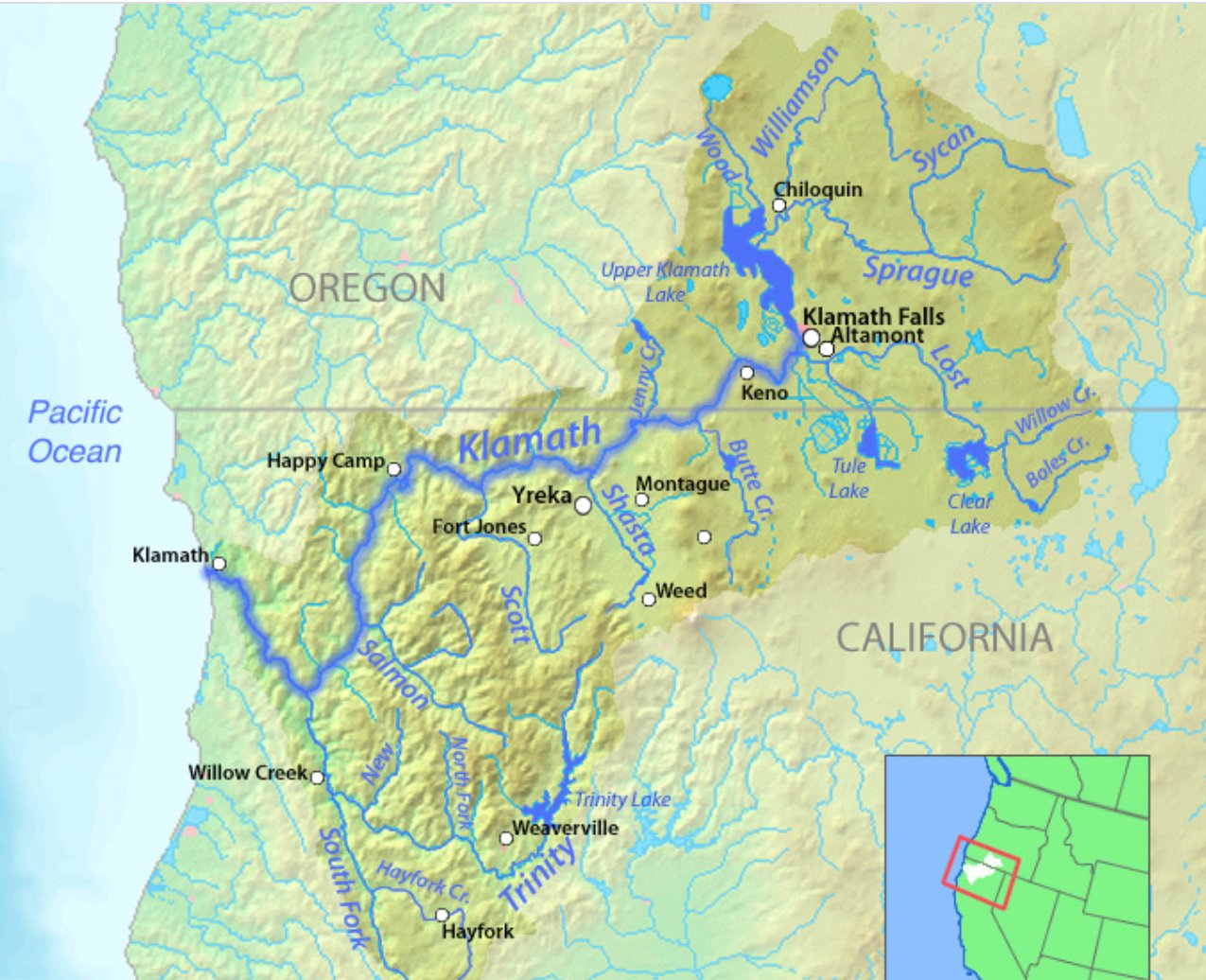Prepare for Change will be regularly featuring reposts from our Nature Restoration Website. Our Nature Restoration Group is a group of Earth Loving humans who are passionate about healing humanity and the planet. We meet every two weeks on Sundays. Our members share ideas and solutions at our meetings, as well as post on our website and facilitate workshops and classes.
Our next meeting will be taking place this coming Sunday, May 30, 2021 at 11:30 AM EDT (New York) time.
For more information about our group and to receive an invite to our next meeting email Shari at [email protected]
To visit our website go to naturerestoration.info

Klamath Basin
Drought Repercussions in the Oregon-California Klamath Basin
Written by Elaine Buxton
Introduction
The western half of the United States is now (2020-2021) suffering from the most severe drought in the past four decades. This is creating a catastrophic scarcity of water for agriculture, fisheries, wildlife and natural habitats with lasting damage that will persist for years, even if the climate improves next year. The Klamath Basin in southern Oregon and northern California is an example of the environmental devastation and loss of food production being experienced in multiple regions on the planet.
Central Europe, too, has had hot dry summers since 2015, attributed to climate change. Scientists have noted changes in the jet stream positions over the continent. The extreme conditions are devastating for agriculture, forestry, ecosystems and societies. Crop losses have tripled in the past 50 years. Study of oak tree rings confirm that the high temperatures and drought is more severe than anytime in the past 2,000 years. (7) the same is occurring in parts of Asia and Africa as well.
Klamath Project and Drought Consequences
The Klamath Project was authorized by the U.S. Congress in 1905 under the Reclamation Act of 1902. It consists of 5 dams operated by the power company Pacific Corp, canals, tunnels, lakes, irrigation systems, and delivery systems with pumping stations. It was built for the specific purpose of irrigation of nearly 200,000 acres.
In response to projected drought years, a major reassessment of how water is allocated to meet the needs of numerous water rights stakeholders was conducted in the fall of 2020 and completed in January 202l. (1) In the past few years, the allocation decisions made by the US Bureau of Reclamation in its duties regarding the Endangered Species Act has shifted away from previous irrigation priorities. (2,6) On May 19, 2021 the Bureau of Reclamation announced that zero amount of water for irrigation would be delivered to the main A Canal from Upper Klamath Lake ( UKL) for 202l for the first time since 1907. (3) Although there is enough water in the UKL to to supply all irrigation needs, it has been stopped in order to protect sucker fish in the lake.(4)
In a study last week, all juvenile coho salmon in the Klamath River were already dead or diseased. In spite of this, 375,000 acre feet of water is scheduled to be released to improve flows in the downstream Klamath River. This is more water than would have occurred naturally in nature without the Klamath Project. Meantime, the dried out irrigation canals are expected to crumble and crack without water.
The California governor recently warned of catastrophic fires in 2021 surpassing the horrors of 2020 as a result of climate change and drought. The salmon die-off is significantly affecting the ocean ecological balance. Forests are drying out in large swaths, then succumbing to enormous fires. Food production for humans and animals will be further restricted. Wildlife cannot survive without water provided by the irrigation runoff into marsh refuges and canals. Humans will lose their ability to work and provide for their families.
Legal Issues
Reclamation is required to comply with Oregon state water laws regarding storage and release of water from UKL. However on January 20, 2021, the Biden Administration, along with Secretary of Interior Deb Hallaland, withdrew all Klamath Project related memorandum, letters, and analysis in Executive Order (EO) 13990 entitled “Protecting Public Health and the Environment and Restoring Science to Tackle the Climate Crisis.” (5) Rep Deb Haaland (D-NM) is the first Native American to lead the Interior federal agency with direct oversight from tribal interests.
The appointment of Secretary Haaland is also in line with the cessation of leases for oil and gas drilling on federal lands, support of the Green New Deal, and political agendas. Numerous litigations have been filed in the aftermath of the aforementioned events as some factions believe the recent operating plans are illegal and inconsistent with the original purpose, reassessment study and overall benefit to the region. (6)
Repercussions
Below is the description of the consequences of the decision to cease all irrigation water releases from UKL by the president of the Klamath Water Users Association.
May 17, 2021
The Honorable Bruce Westerman
Ranking Member
Committee on Natural Resources
Republican Office
U.S. House of Representatives
1329 Longworth House Office Building
Washington, D.C. 20515
Re: May 19 Virtual Forum on the Catastrophic Drought Situation Across the American West
Dear Ranking Member Westerman and Natural Resources Committee Republicans:
Thank you for conducting this forum on issues of fundamental significance to the west. I am Ben DuVal, President of the Board of Directors of Klamath Water Users Association (KWUA). KWUA is a non-profit organization whose members are irrigation districts that deliver water in the Klamath Project. I farm in the California part of Klamath Project lands, along with my wife and two daughters. We live on the farm homesteaded by my grandfather after World War II.
The Klamath Project was authorized in 1905 under the 1902 Reclamation Act, which encouraged settlement and irrigated agriculture to feed a hungry nation. The Project was a resounding success, built out to its current 200,000 acres by the early 1940s, producing food and supporting strong rural communities.
The irrigated land lies in Klamath County, Oregon, and Modoc and Siskiyou Counties, California.
Contrary to stereotypes about irrigated agriculture, this land was not desert before irrigation began. Vast areas of land covered by open water and marsh were reclaimed and the former lake bottoms provide productive farmland. The evaporation and evapotranspiration of water prior to development was likely greater than the amount of water used by crops on those same lands today.
Agricultural production in the Project includes grass and alfalfa hay, grains, potatoes, onions, mint for oil and tea, and horseradish. All of our crops are known for their high quality due to our climate and soils. Beef and dairy cattle are also major components of the agricultural economy.
Our use of water is extremely efficient. We need access to about three percent of the total runoff in the Klamath River watershed in order to irrigate all of the land. This year we will receive essentially zero percent, and 400,000 acre-feet less than what we need.
We do have a drought this year, but in past droughts of this magnitude we in fact diverted 400,000 acre-feet of water. The reason that dams and water storage are developed is to protect water users from drought. In the Klamath Project, Upper Klamath Lake provides storage of enough water to serve all the irrigated land for the year. The Klamath Project is a single purpose project, and the water rights for storage and use of water are irrigation water rights.
However, in recent years, the water we relied on for over 100 years has increasingly been re allocated to protect two endangered species of suckers and coho salmon that make use of the Klamath River and tributaries in California.
In the past drought years when roughly 400,000 acre-feet of water was diverted for irrigation, there were no known negative impacts to salmon returns or sucker populations. In fact, the National Research Council, National Academy of Sciences, found that there was no data to support that this level of diversion in those years had negative effects on populations of threatened and endangered fish in Upper Klamath Lake or the Klamath River in California.
The first water delivery from the A Canal, which is operated by Klamath Irrigation District, was in 1907. 2021 is the first year ever that the A Canal will deliver zero water. That means that about 150,000 acres will get no water through the Klamath Project.
Your average farmer has mortgage payments, property taxes, irrigation district assessments, equipment payments, and the most important need of all: to house and take care of his or her family. No water means no crops, no food, no ability to take care of your family.
Many producers have contracts that they have worked years to achieve and retain. If producers cannot deliver on those contracts to, for example, Safeway, Walmart, or Whole Foods, those contracts are lost.
Beef and dairy producers lack forage ground because of the lack of precipitation and inability to irrigate. Hay is in short supply and prices have increased dramatically. Beef and dairy producers are forced to liquidate herds in order to derive some income and reduce costs, and rebuilding herds requires years and additional debt. In addition, increased supply of cattle to the market causes reduction in cattle prices.
Agriculture supports jobs. The agricultural community is greatly concerned about the well-being of the workforce, many of whom are long-time residents. We are afraid of losing folks who are not only great employees but are valued members of our communities.
Klamath Project agriculture generates roughly $400 million in economic activity in the region. The impacts of shutting down agriculture–the driver of the local economy–will also cause harm to ag supply businesses: seed and equipment dealers, agricultural service companies, all the way to Main Street. Like everywhere else, local business is finally seeing the light at the end of the COVID tunnel, but with the shut-down of agriculture this year, that light is the proverbial train coming at us.
We are very worried about negative environmental impacts and public health and safety impacts.
The waterfowl, reptiles, and amphibians that rely on our canal system, ditch banks, and irrigated fields will simply not be there as there is no water in the canals nor on the fields.
There have been, and will continue to be, dust storms. Think dustbowl. No exaggeration.
Two national wildlife refuges rely exclusively on the Klamath Project water infrastructure. They will receive zero water for those wetlands and habitats this year.
But that leads to another problem. There are 1,800 domestic wells in Oregon alone that are within the geographic area served by the A Canal. Ordinarily, that canal water recharges those shallow domestic wells, but this year it will not. Meanwhile the limited irrigation groundwater pumping will continue to draw down water levels. We are engaged in a grand experiment to find out how many domestic wells will go dry, and no one has even a guess how many that will be.
With all that said, we realize that we are not alone in this watershed, and there are important interests. Most notably, there are several tribes who, we recognize were here for many millennia before European settlement and who have a tragic history. Three of the basin tribes have federally-protected fishing rights that require protection and water.
Our concern, however, is that, in this complex ecosystem, where a great many factors have affected and are affecting fish populations, the go-to solution is increasing regulation and reduction of Klamath Project irrigation use, and it has not done and is not helping the species.
Things have gotten out of whack. Theoretically, we are shut off in order to avoid impacts to endangered fish. But we are not diverting any water at all; what impact is it that we are offsetting?
We also strongly believe that there are critical legal issues that need to get fixed. Farmers and irrigation districts have strong objections to the re-allocation of stored water. Everyone in the west knows that we build dams and reservoirs to capture water during the wet time of year, when there are high flows, in order to have water available at the dry time of year, which is summer. We have done that in the Klamath Project and irrigation districts pay for the infrastructure that provides that storage.
But the government is requiring that we direct the release of the stored water away from farms in order to artificially increase the amount of flow in the Klamath River. During the irrigation season, the Klamath Project will be providing much more flow in the Klamath River than would have occurred in nature before the Project even existed.
We believe that is a legal problem that needs to get straightened out.
We must also get away from the paradigm of regulating the Klamath Project just because you can. There is a federal nexus at the Klamath Project which results in Project farmers and ranchers being looked to for water to attempt to cure and mitigate whatever factors are affecting fish populations. That is not fair, and it has not work for farms or fish.
For long-term stability, we need a settlement agreement about water and fish and fair and legal treatment of the Klamath Project. There are critical parties to make this happen, and we need support of that work from the state and federal governments and our community. It can be done; it has been done elsewhere.
For the very immediate term, we need financial resources to try to hold it together and try to avoid an absolutely catastrophic meltdown. We need that help immediately. We are almost past the point where a stitch in time can save nine. We do not want to be in this cycle of crises but this year we face a terrible fate that makes it essential to receive disaster funding support immediately. We appreciate the diligent efforts to date of Congressmen Bentz and LaMalfa and Senators Merkley, Wyden, Padilla, and Feinstein, all of whom are familiar with the needs that we have. We respectfully seek support from each of you as our communities try to cope with a very grave situation.
I want to add that this is going to be a very bad for salmon fishermen, tribal and non-tribal. We may have disagreements with those communities about the cause of the low salmon returns, but those people are not at fault. I hope Congress will be receptive to their information and needs also.
If you have questions or need more information, please contact me or Paul Simmons, KWUA’s executive director, at 541-883-6100.
Thank you for considering our testimony.
Ben DuVal
Farmer, & President of Klamath Water Users Association
References
1. US Bureau of Reclamation. Reassessment of US Bureau of Reclamation Klamath Project Operations to Facilitate Compliance with Section 7 (a) of the Endangered Species Act. Https://law.berkley.edu. January 2021.
2. Johnson, Brittany K and Ramsey E Kropf. Bureau of Reclamation Updates Its Approach to ESA Section 7 Consultations for Klamath Project Operations, Applying Recent Legal Authorities and New Solicitor Guidance. Somach Simmons & Dunn, Attorneys At law. Https://somachlaw.company/policy/bureau-of-reclamation-upd. Jan 21,2021.
3. Simmons, Paul. Klamath Water Users Association: Worst Day In the History of the Klamath Project. Https://kwua.org/klamath-water-users-association-worst-day-in-thehistory-of-the-klamath-project/. 5/19/21
4. DuVal, Ben. May 19 Virtual forum on the Catastrophic Drought Situation Across the American West. Klamath Water Users Association. Https://kwua.org/may-19-forum-on-the-catastrophic-drought-situation-across-the-american-west/ 5/19/21
5. Haaland, Deb, Secretary of the Interior, Washington. Memorandum: Withdrawal of Klamath Project-Related Memoranda, Letters, and Analysis. April 8, 2021.
6. Simmons, Paul, KWUA Executive Director. Bureau of Reclamation Updates Guidance for Klamath Project Operations Under endangered Species Act and Water Law. Https://kwua.org/bureau-of-reclamation-updates-guidance. 5/19/21.
7. University of Cambridge. Recent Summer Droughts in Europe Are Far More Severe Than Anything in the Past 2,000 years. www.scitechdaily.com. Mar 22, 2021
Disclaimer: We at Prepare for Change (PFC) bring you information that is not offered by the mainstream news, and therefore may seem controversial. The opinions, views, statements, and/or information we present are not necessarily promoted, endorsed, espoused, or agreed to by Prepare for Change, its leadership Council, members, those who work with PFC, or those who read its content. However, they are hopefully provocative. Please use discernment! Use logical thinking, your own intuition and your own connection with Source, Spirit and Natural Laws to help you determine what is true and what is not. By sharing information and seeding dialogue, it is our goal to raise consciousness and awareness of higher truths to free us from enslavement of the matrix in this material realm.
 EN
EN FR
FR


























